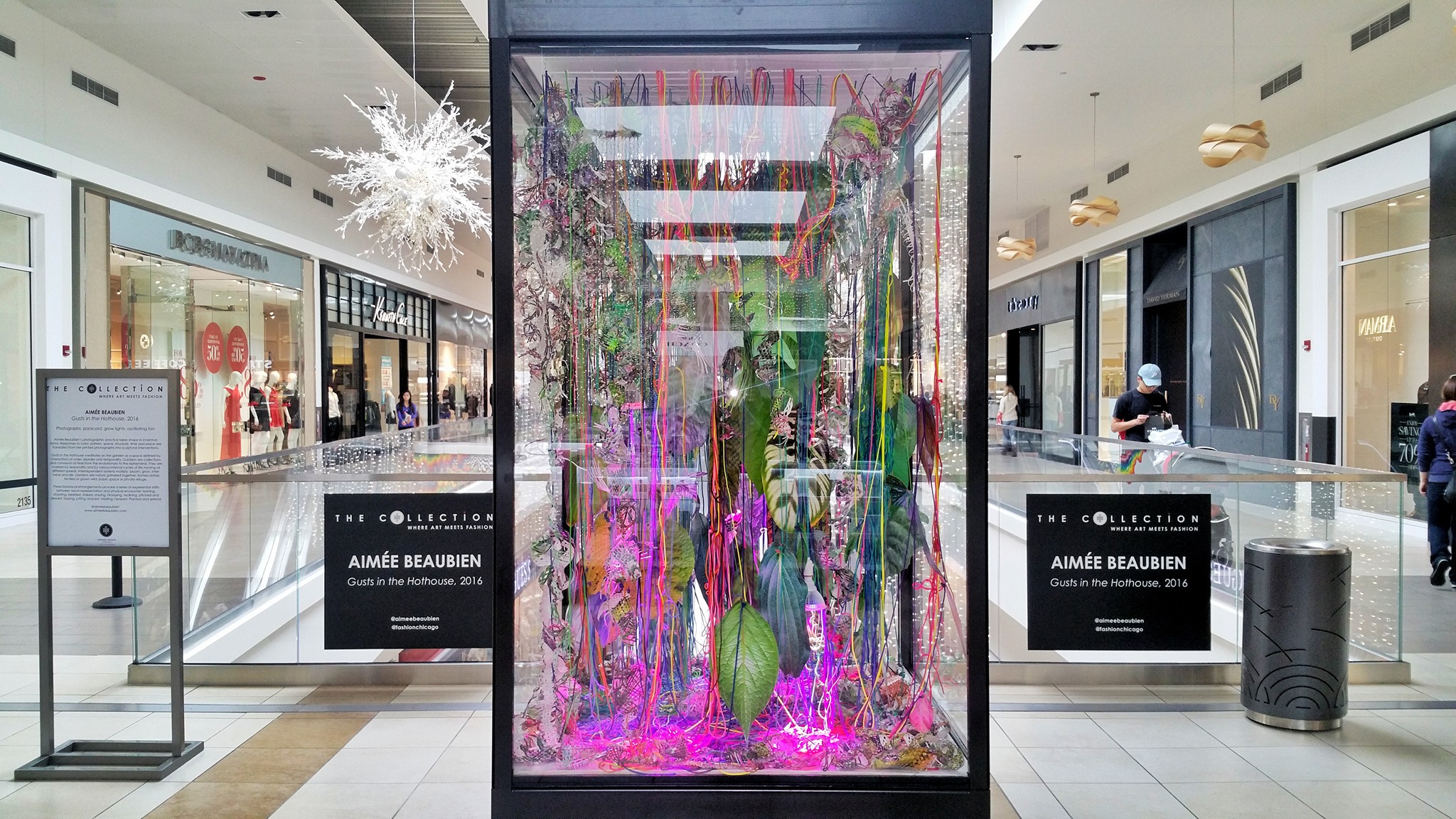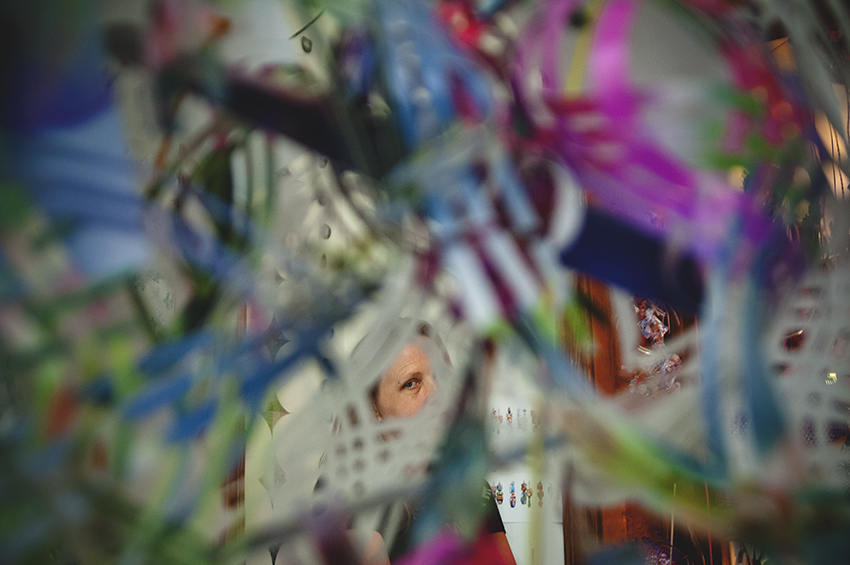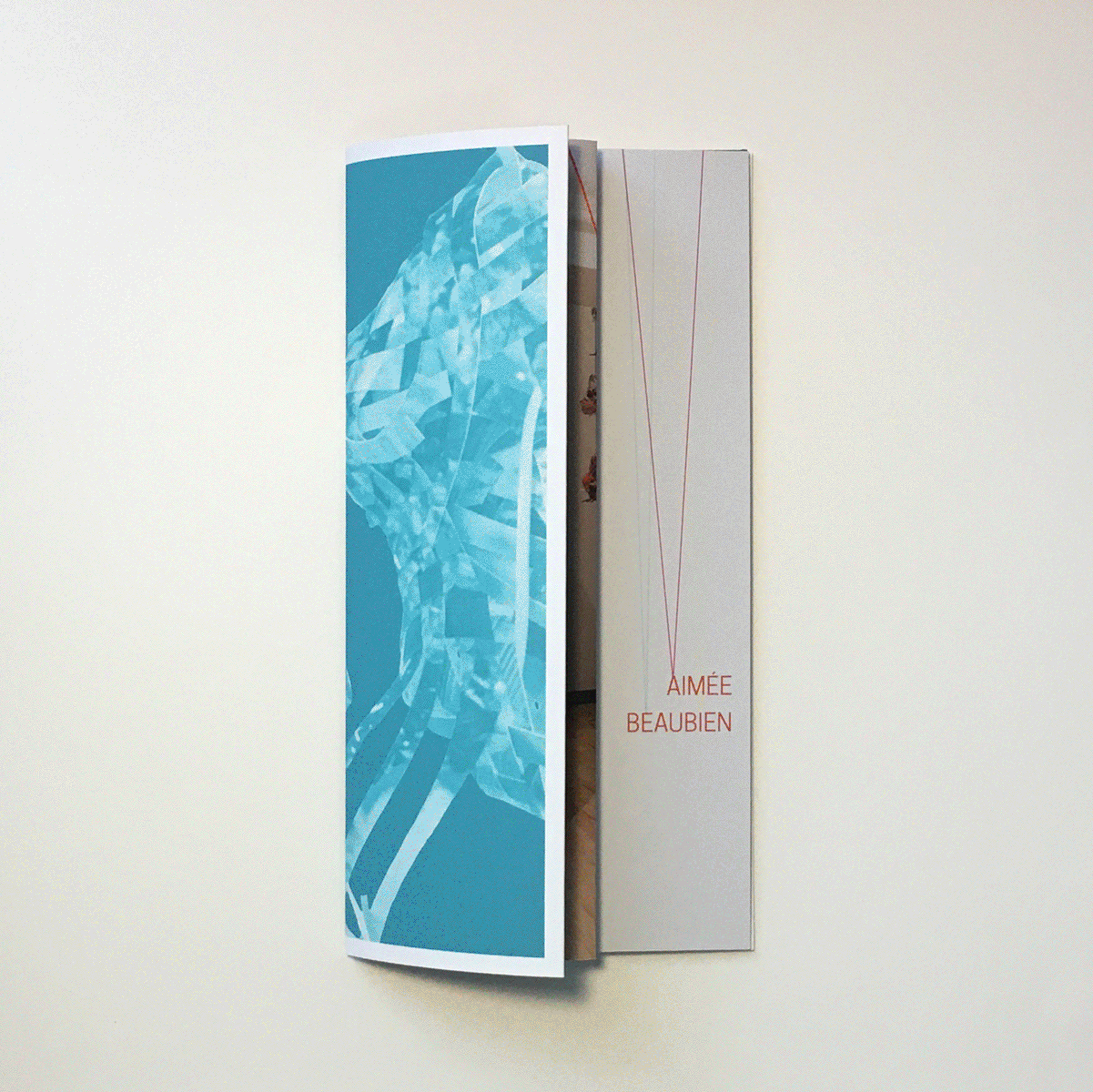PELICAN BOMB | MARCH 16, 2018
As part of our “Queer Tropics” editorial series, Kayl Parker talks to artist Aimée Beaubien about her foliage-filled installations made from cut-and-collaged photographs.
EDITOR'S NOTE
Aimée Beaubien is an artist living and working in Chicago, Illinois. Beaubien is Assistant Professor of Photography at the School of the Art Institute of Chicago, where I studied under her in the photography department. She utilizes photography and sculpture to blur the lines between media, while challenging the characteristics artists often automatically assign to each. Beaubien creates large-scale, immersive installations made from cut photographs and other objects. These pieces are often woven together and hung to overwhelm the room as well as the viewer.
In the last year, Beaubien has shown work at Riverside Arts Center, Riverside, Illinois; Gallery UNO Projektraum, Berlin; and Platform, Evanston, Illinois. She recently released Cuttings, a limited-edition artist book in collaboration with Jennifer Keats and the Donut Shop in Chicago.
Last fall, we sat down to talk about her work.
—Kayl Parker
Kayl Parker: I’d like to begin by talking about the source imagery for your large constructions. Where does it originate, or how do you generate it? Where does that process start?
Aimée Beaubien: Primarily, I’m using my own photographs. I also have a huge archive of photographs from my great-grandmother constantly circulating in my consciousness. I’m always thinking about them, looking at them, and sometimes incorporating them into my work. But it is really 99 percent my own photographs.
The work that opened up this new way of working started when I had the opportunity to be an artist in residence at the Roger Brown Study Collection in Chicago a few years ago. I was photographing in the collection for over a year, and I was really attracted to the idea of learning about this artist through the things he chose to surround himself with in his home space, his domestic space, and his studio space. And his home on Halsted Street, have you ever been there?
KP: Yes, a few times.
AB: It’s a two-flat, sort of like what I have set up here with the studio on the first floor, living areas primarily on the second floor. Things from his domestic space infiltrate the studio space, so there’s this migration of really interesting materials traveling upstairs and downstairs. And what I love about his collecting style is that it was so democratic, low culture with high culture, works by his friends, advertisements, vernacular things. It was a really exciting experience to fantasize about who I thought he was and how his collection affected him.
I was also thinking about my great-grandmother, because she was a collector too. She survived the Depression so she was constantly recycling materials, and we were constantly collaging things together. I think she is my primary influence. In 2016, I had the opportunity to do an installation at the Museum of Contemporary Photography (MoCP) in Chicago for an exhibition celebrating their collection. I started thinking about the different types of histories and personal and institutional collections.
I also had the opportunity to go to Brown’s home in Michigan. There’s a whole bunch of biographical information available to read while you’re staying there. He had 50 different types of roses on that property at one time. Even the garden was an extension of his collection. The collecting was compulsive and it happened in every aspect of his life.
I have all these photographs from my great-grandmother. She was constantly photographing her garden throughout the seasons, so I’ve always casually photographed my mom’s garden. In 2013, I just switched gears (snaps) and thought this could be my primary material. I could expand the idea of the garden as a collection.
I love the idea of going to someone’s garden and trying to get a sense of who they are through the way they tend it. My mom’s really hard to get to know, so I feel like I can know her better through the way she manages and cultivates this natural-looking space.
KP: So the garden is a personal history?
AB: Totally! It’s funny, my husband and I got married in our backyard garden in Wicker Park, and when we moved later we transplanted a whole bunch of those plants. They’re a reflection of ourselves, I think.
KP: I’ve never thought about the garden as an extension of the human that owns it, but it makes sense.
AB: The other thing I’m always paying attention to is how these life cycles are very similar to photography. I think about my great-grandmother and her impulse to capture something ephemeral, like a bloom or blossom. She wanted to hold on to it. Having cut flowers in her house isn’t enough, she has to preserve it in a photograph.
KP: It’s often hard to pinpoint a medium with your work. The final pieces sort of dance around the line of photography and sculpture. Is this ambiguity important?
AB: It’s a complication that has been persistently looming over me. Where am I in this art world? So many people assume with collage work that the artist is primarily working with appropriated material, so when I was a young artist I had to assure people that not all collage is found material. I didn’t feel so much pressure to determine what kind of artist I was outside of school, but being a professor in a photography department, I felt then like I always had to reassure people that I know how to use a camera and work in a dark room. That’s my background and training. I’m interested in pushing photography outside of these predetermined forms and seeing how flexible it is, because I think photography is very malleable.
When I was documenting my collage work, I would get super frustrated, because it would look so flat. You couldn’t really see the ways I was joining two radically different pictures together, it just seemed like a photoshop trick. So I thought, how can I photograph this so it looks more dimensional? Which led to, why don’t I just make the works themselves more dimensional? At first I just had things in a little bit of a relief off the wall, and then I just really needed to get into space. I’m not a sculptor, so I was teaching myself all these things, giving myself simple problems, or a simple question that was actually a much more complex problem, like how do I make a photograph stand up on itself? (laughs)
In the process of doing that, I was naturally pulling things from my domestic space to prop them up while I was making. I think it helped having spent so much time with the Roger Brown stuff; I began thinking these things could become an integral part of the sculpture. They make sense. So a lot of this stuff is pulled from my garden into my studio space. I let things dry, or they die. I used to be a monochromatic artist, and in my very first sculptural installation, I embraced color, and my color just went wild. I put a whole bunch of dried lemons in it, because I love the idea of these super sweet photographs with this sour presence of the dead lemon.
KP: People tend to speak very differently about photography than they speak about painting or sculpture, as if it’s a lowbrow art form, somehow less masterful—which circles back to your need to convince people that you were personally generating the photos you used. They weren’t all found; they were yours, original. In a way, we have to consistently validate photography as a fine art form.
AB: I joined a critique group that was all photographers, as a kind of test. Can I convince very conservative photographers that what I’m doing has meaning and value in the photo world?
KP: It’s a challenge. I think about all the critiques I had in the photo department at SAIC, and there are always people who are purists.
AB: And I value that. I teach that. I feel like it’s so much easier now that there are many artists working with photography in bizarre ways. It’s helped me in that I don’t feel alone.
KP: So many of your installations create spaces with loose narratives. Do you have a final form in mind before you start, or is the process more fluid than that?
AB: These are all new muscles I’m trying to build, so I’ve started out with very specific ideas in mind. What I consider my very first installation element was in a show at Johalla Projects where I built this vine-like structure climbing up a wall. I was basically imitating the way this wild rogue vine has crawled around our house, covering the side of our house from two doors down. I love seeing how plants travel through the neighborhood. I wanted to replicate the feeling of those movements and gestures.
I had also been reading J.G. Ballard’s The Drowned World, which imagines this post-apocalyptic world that has been completely flooded. London is underwater and vegetation is crazy out of control, jungles growing over architecture. For an installation at Demo Project, which was in an actual house, I imagined building this platform of furniture oddly stacked up, and then a beanstalk just growing all over it. Again, that was coming primarily from the book, but also this vine.
And then the next big installation was at the MoCP. I felt the pressure to respond to what has been an anchor in igniting my imagination about the history of photography, specifically William Henry Fox Talbot’s work photographing his collections. He has one [photograph] with shelves and articles from China, so what I tried to conceptualize was creating a china cabinet or cabinet of wonders in this architectural niche [at the museum]. I cut vessel forms into all the photographs I’d taken in the Roger Brown house of his objects. I liked the idea that a photograph is a vessel. I was creating a weird china cabinet in that space. I knew that this would be the primary element, I had that all visualized before I did it.
Because I really want to stay sensitive and responsive to the actual space. I can’t control my response. I can’t create that in the studio, I can just approximate it.
KP: By creating the pseudo-landscapes or jungles in your installations, how do you hope the viewer relates to or inhabits the space of the work?
AB: Ideally, I would love people to feel like they are inside of it. Some exhibition spaces can’t accommodate that, but I’m hoping that people feel they can walk inside. I know from having studio visits that a lot of people have the impulse to touch things, which I’m totally okay with. This is all material that I handle without gloves, so as long as they’re not pulling, tugging, bending, it’s fine. I keep thinking about working with stronger material.
KP: I judge artwork on the initial visceral reaction I have to it, like a first impression. So if I feel the urge to touch it, I almost feel like it’s more successful as a piece.
AB: I love when people come in here and just sort of gasp, and say “Whoa, this is amazing.” That’s what I’m going for.
KP: The first reaction I had to these hanging pieces is to point out all the visual parts I’m drawn to, which might not be constructive. But it’s almost as if you have to experience this initial awe, because it is aggressive. That visceral reaction can force you to zoom in and question what you’re looking at.
AB: That’s what I actually love, the idea of watching people encountering the work for the first time, and they don’t know what they’re looking at. They don’t come with any preconceived ideas that they’ll be seeing photographs today. What am I looking at? What is this? I think there is enough material information available that you can figure it out.
KP: Do you want people to see your hand in the artwork? Do you hope some of that personal history is showing?
AB: That’s an interesting question. I do value that I am making all these cuts by hand. I could probably have this all laser cut, but I want to make my cuts in direct response to the photographs. I thought about having all the vinyl pieces cut with the laser cutter, but it just didn’t make much sense to me when I’m so much more adept with an X-Acto. I can really be in the moment making decisions, on the print instead of a file. All the mark-making, knowing that it’s me or my hand behind it makes it more meaningful to me. I’m not sure if it comes across to the viewer.
KP: I think it reads as organic. I think if you did everything through a computer, it would be noticeable. You can see your hand cutting out something more organically than with a digital selection tool.
AB: It’s funny. I did an installation in Houston, and a friend of mine took the installation down for me. He saw me put it up, but he said he really didn’t understand it until he took it apart. He said, “I kind of feel like I’m inside your brain.” Which I think is cool, but why did it have to wait until he was actually de-installing? I guess the way that I approach work is I firstly take it all in, but then I try to figure out how it was all made. That’s just part of my viewing process.
KP: That might be an artist thing, because we all want to know. And it’s not always incredibly important to consuming the work, but it does inform the experience.
AB: Definitely. And honestly, this is so snarky of me, but a lot of people are cutting paper now, and I can always tell when it’s laser cut. I shouldn’t be so prejudiced. (laughs)
KP: I do the same thing, I really do. I think artists all do it to a certain extent, and maybe not even consciously all the time. I do it now when I watch movies even.
AB: Oh yeah! We can’t suspend our disbelief.
KP: It’s the plight of the maker, right?
AB: I’ve been pulling these long days in the studio, and I’ve been having these really intense dreams. I always have very intense, vivid dreams when I’m stressed out, especially. I had these vines, the vines again, they’re coming across my body and weaving together. I could feel tendons and muscles weaving together, and it was crazy. I would move, and then I would think, “that wasn’t the right move,” and readjust in response to the way these things were weaving through my body.
KP: So your work is you, your work is fused literally to you.
AB: At the moment it is! I’m totally obsessed with this weaving thing, and I’m not sure where it’s going to go. That’s part of why I’m excited by it.














